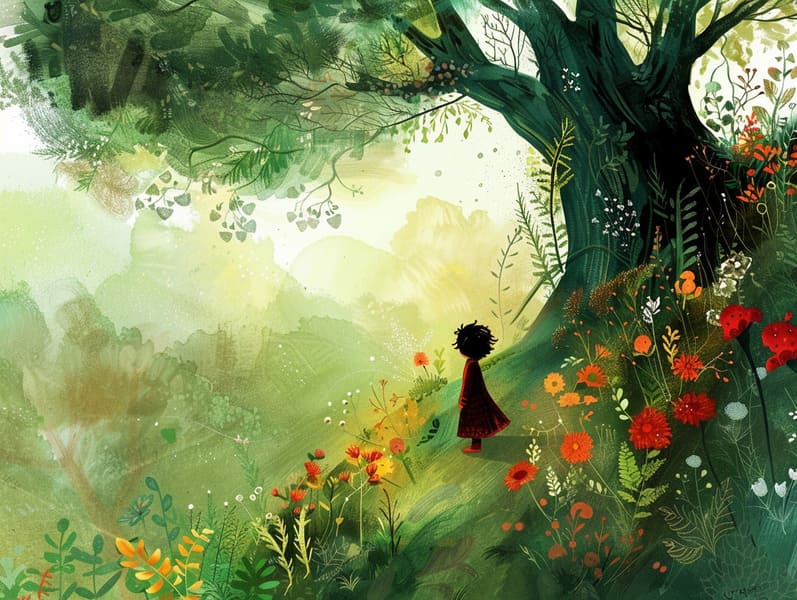
Best fairy tales have ancient roots. These tales have been relayed from one generation to the next well before they were ever inscribed. They emerged from a variety of civilizations, including European traditions. They were initially conveyed among mature audiences, often carrying themes and messages relevant to the societal norms and beliefs of the time.
The famous Grimm duo, Jacob and Wilhelm, were among the first to collect and release many of these beloved tales. Their published works, "Grimm's Children's Stories," included narratives like "The Little Glass Slipper," "The Story of Hansel and Gretel," and "Little Snow White," which have since become staples in the world of traditional fairy tales. Similarly, H. C. Andersen's enchanting stories, such as "The Sea Maid," and "The Ugly Duckling," have captured hearts worldwide, ensuring their place in the pantheon of iconic fairy tales.
Even though they are old, these stories remain as applicable as ever, especially as children's bedtime stories. These charming stories are now available in numerous formats, including richly illustrated books, whimsical animations, and online fairy tales.
Their lasting appeal can be attributed to several enchanting factors:
Moral Lessons: Traditional fairy tales often present important moral lessons. Tales like "The Tale of the Boy Who Cried Wolf" teach the significance of truthfulness, while "The Tale of the Tortoise and the Hare" exemplify the values of perseverance and humbleness. These stories offer little ones clear distinctions between ethical and unethical, helping to shape their moral compass in a subtle yet lasting way.
Empathy and Awareness: Classic fairy tales frequently feature heroes facing tests and troubles, inciting audiences to connect with their struggles and rally behind their triumphs. For instance, "The Tale of Beauty and the Beast" illustrates the necessity of looking beyond appearances to perceive the inner core of a being, promoting sympathy and awareness.
Cultural Insights: Many classic fairy tales are deeply ingrained in the cultural contexts from which they arose. Learning from these narratives can provide illuminating insights into different traditions, strengthening a sense of cultural insight and comprehension.
Fantasy and Imagination: The fantasy-filled elements in classic fairy tales—fairy godmothers—spark children’s innovations. These fairy tales lead readers to otherworldly realms, generating innovative dreams and a sense of astonishment that remains a lifetime.
Traditional fairy tales are not only enchanting but also teaching. They act as spellbinding tools in enhancing various brain and heart skills in kids. When traditional fairy tales are read aloud, they advance language proficiency by presenting new lexicon and sophisticated sentence structures. This practice also fosters hearing perception and attention, as young readers pay close attention, anxious to see what happens next.
Furthermore, examining the themes and characters of traditional fairy tales can sharpen analytical skills and reasoning skills. The young are taught to recognize patterns, foresee events, and make sense of cause and effect. These discussions also advance children articulate their thoughts and feelings, contributing to their emotional intelligence.
In today’s digital age, the existence of online fairy tales has made these tales more available than ever. Web-based platforms and web apps offer wide arrays of popular fairy tales that can be seen or listened through anytime, anywhere. Fairy tales told out loud are particularly favored, offering an immersive method for little ones to engage with these charming stories. Sound books and voiced videos guide characters and settings to life, often joined by delightful background sounds and soundtracks that enhance the narrative experience.
The unfading fascination of ancient fairy tales lies in their ability to change to changing times while continuing with their fundamental ideas. Contemporary renditions of these narratives often incorporate more different characters and modern settings, making them familiar to today’s audience. However, the fundamental themes of daring, humanity, and even-handedness remain unchanged, continuing to strike a chord with audiences of all ages.
Traditional fairy tales also offer a sense of security and familiarity. They yield a well-structured narrative with a distinct beginning, middle, and end, often coming to a close with the ending of conflicts and the triumph of morality over immorality. This predictability can be easing for the young, granting a sense of unchangeability in an variable world.
Old fairy tales continue to allure and guide new generations, maintaining their magic and significance in modern society. As kids' bedtime tales, they introduce a perfect blend of magic and knowledge, encouraging moral values, empathy, and creativity. The existence of internet fairy tales and the prevalence of fairy tales voiced assure that these ancient stories remain acquirable to new generations.
By safeguarding and narrating these fairy tales, we continue to admire the rich tapestry of human imagination and cultural heritage. Whether find it here you are viewing a colorful picture book, enjoying a electronic collection, or listening to an sound book, the beauty of famous fairy tales is always within reach. These fairy tales point out of the unceasing impact of narratives and its ability to bind us across centuries and lands.
No matter if you are enjoying a colorful picture book, experiencing a internet library, or hearing an spoken story, the magic of old fairy tales is always within reach.
These tales teach us of the unwavering effect of tales and its ability to tie us across time and space, making a tie that enchants and educates alike.